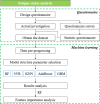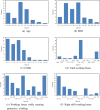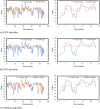Analysis of the fatigue status of medical security personnel during the closed-loop period using multiple machine learning methods: a case study of the Beijing 2022 Olympic Winter Games
- PMID: 38637575
- PMCID: PMC11026406
- DOI: 10.1038/s41598-024-59397-6
Analysis of the fatigue status of medical security personnel during the closed-loop period using multiple machine learning methods: a case study of the Beijing 2022 Olympic Winter Games
Abstract
Using machine learning methods to analyze the fatigue status of medical security personnel and the factors influencing fatigue (such as BMI, gender, and wearing protective clothing working hours), with the goal of identifying the key factors contributing to fatigue. By validating the predicted outcomes, actionable and practical recommendations can be offered to enhance fatigue status, such as reducing wearing protective clothing working hours. A questionnaire was designed to assess the fatigue status of medical security personnel during the closed-loop period, aiming to capture information on fatigue experienced during work and disease recovery. The collected data was then preprocessed and used to determine the structural parameters for each machine learning algorithm. To evaluate the prediction performance of different models, the mean relative error (MRE) and goodness of fit (R2) between the true and predicted values were calculated. Furthermore, the importance rankings of various parameters in relation to fatigue status were determined using the RF feature importance analysis method. The fatigue status of medical security personnel during the closed-loop period was analyzed using multiple machine learning methods. The prediction performance of these methods was ranked from highest to lowest as follows: Gradient Boosting Regression (GBM) > Random Forest (RF) > Adaptive Boosting (AdaBoost) > K-Nearest Neighbors (KNN) > Support Vector Regression (SVR). Among these algorithms, four out of the five achieved good prediction results, with the GBM method performing the best. The five most critical parameters influencing fatigue status were identified as working hours in protective clothing, a customized symptom and disease score (CSDS), physical exercise, body mass index (BMI), and age, all of which had importance scores exceeding 0.06. Notably, working hours in protective clothing obtained the highest importance score of 0.54, making it the most critical factor impacting fatigue status. Fatigue is a prevalent and pressing issue among medical security personnel operating in closed-loop environments. In our investigation, we observed that the GBM method exhibited superior predictive performance in determining the fatigue status of medical security personnel during the closed-loop period, surpassing other machine learning techniques. Notably, our analysis identified several critical factors influencing the fatigue status of medical security personnel, including the duration of working hours in protective clothing, CSDS, and engagement in physical exercise. These findings shed light on the multifaceted nature of fatigue among healthcare workers and emphasize the importance of considering various contributing factors. To effectively alleviate fatigue, prudent management of working hours for security personnel, along with minimizing the duration of wearing protective clothing, proves to be promising strategies. Furthermore, promoting regular physical exercise among medical security personnel can significantly impact fatigue reduction. Additionally, the exploration of medication interventions and the adoption of innovative protective clothing options present potential avenues for mitigating fatigue. The insights derived from this study offer valuable guidance to management personnel involved in organizing large-scale events, enabling them to make informed decisions and implement targeted interventions to address fatigue among medical security personnel. In our upcoming research, we will further expand the fatigue dataset while considering higher precisionprediction algorithms, such as XGBoost model, ensemble model, etc., and explore their potential contributions to our research.
Keywords: Case study; Fatigue analysis; Machine learning; Medical security; Questionnaire survey.
© 2024. The Author(s).
Conflict of interest statement
The authors declare no competing interests.
Figures







Similar articles
-
Enhancing the Predictive Performance of Molecularly Imprinted Polymer-Based Electrochemical Sensors Using a Stacking Regressor Ensemble of Machine Learning Models.ACS Sens. 2025 Apr 25;10(4):3123-3133. doi: 10.1021/acssensors.5c00364. Epub 2025 Apr 17. ACS Sens. 2025. PMID: 40241481
-
Exploring Ensemble Learning Techniques for Infant Mortality Prediction: A Technical Analysis of XGBoost Stacking AdaBoost and Bagging Models.Birth Defects Res. 2025 Feb;117(2):e2443. doi: 10.1002/bdr2.2443. Birth Defects Res. 2025. PMID: 39917850
-
Seasonal prediction of daily PM2.5 concentrations with interpretable machine learning: a case study of Beijing, China.Environ Sci Pollut Res Int. 2022 Jun;29(30):45821-45836. doi: 10.1007/s11356-022-18913-9. Epub 2022 Feb 12. Environ Sci Pollut Res Int. 2022. PMID: 35150424
-
Data-driven modeling and prediction of blood glucose dynamics: Machine learning applications in type 1 diabetes.Artif Intell Med. 2019 Jul;98:109-134. doi: 10.1016/j.artmed.2019.07.007. Epub 2019 Jul 26. Artif Intell Med. 2019. PMID: 31383477 Review.
-
Role of machine learning algorithms in suicide risk prediction: a systematic review-meta analysis of clinical studies.BMC Med Inform Decis Mak. 2024 May 27;24(1):138. doi: 10.1186/s12911-024-02524-0. BMC Med Inform Decis Mak. 2024. PMID: 38802823 Free PMC article.
References
-
- Lang X, Wang Q, Huang S, Feng D, Ding F, Wang W. Relations among perceived stress, fatigue, and sleepiness, and their effects on the ambulatory arterial stiffness index in medical staff: A cross-sectional study. Front. Psychol. 2022;28(13):1010647. doi: 10.3389/fpsyg.2022.1010647. - DOI - PMC - PubMed
-
- Li L, et al. Analysis of fatigue status and influencing factors of officers and soldiers during closed management of novel coronavirus pneumonia epidemic situation. Acad. J. Second Military Med. Univ. 2021;42(4):451–456. doi: 10.16781/j.0258-879x.2021.04.0451. - DOI
MeSH terms
Grants and funding
LinkOut - more resources
Full Text Sources

